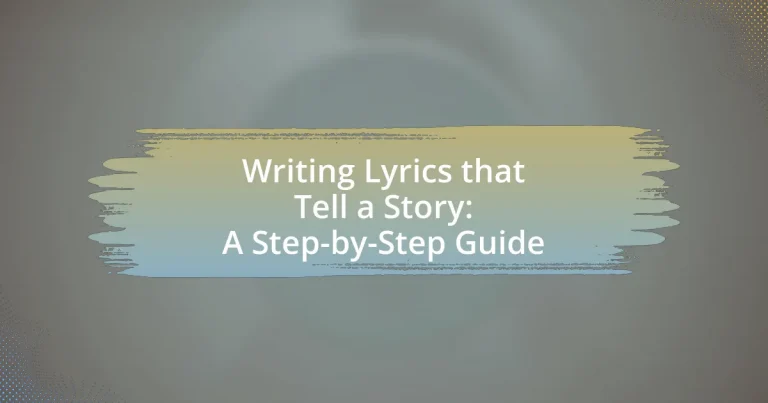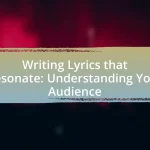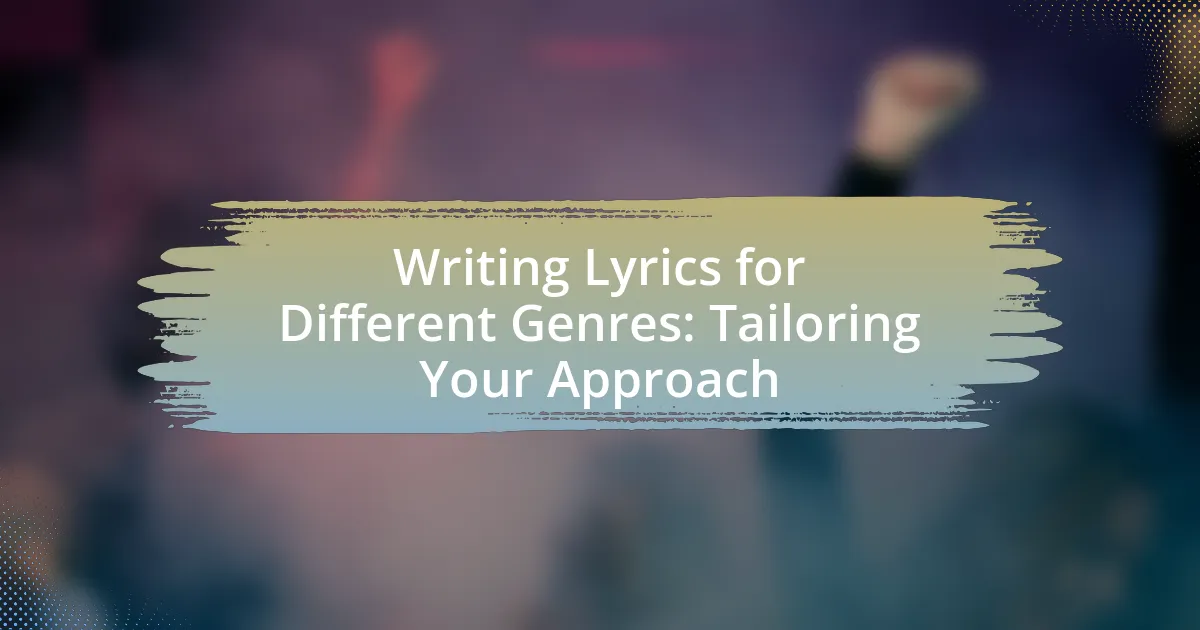The article focuses on the process of writing lyrics that tell a story, emphasizing the importance of narrative elements such as character development, setting, conflict, and resolution. It outlines how storytelling enhances emotional connections with listeners, making songs more memorable and impactful. Key techniques for crafting story-driven lyrics are discussed, including brainstorming ideas, maintaining a consistent narrative voice, and utilizing imagery and metaphor. Additionally, the article provides practical steps for refining lyrics and avoiding common pitfalls, ultimately guiding songwriters in creating compelling narratives within their music.
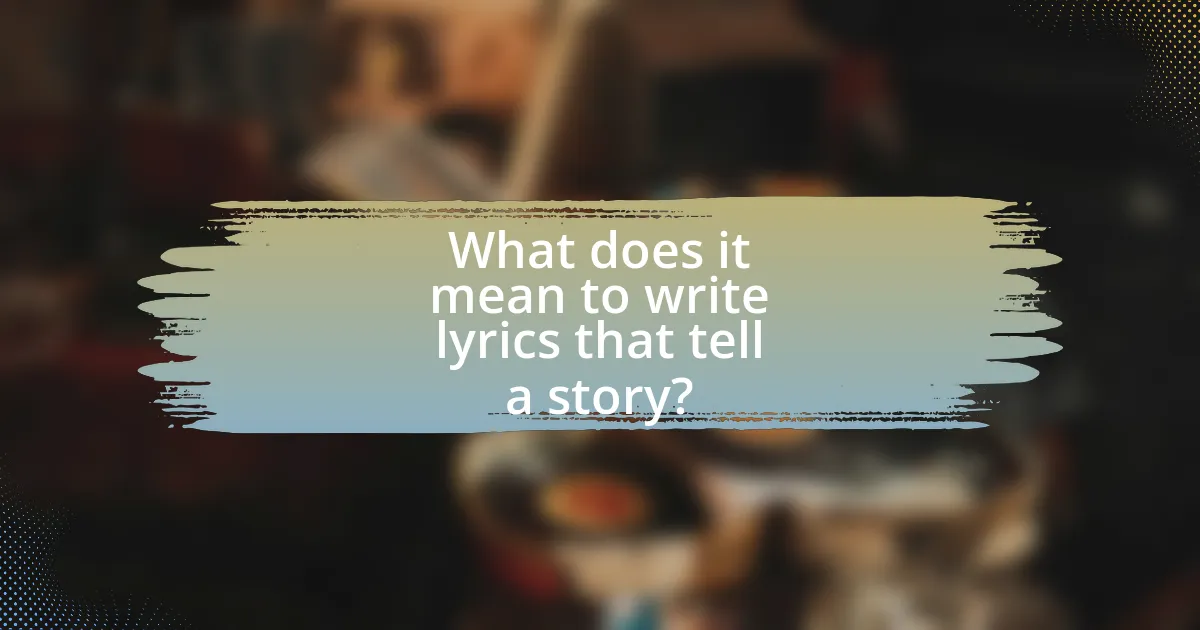
What does it mean to write lyrics that tell a story?
Writing lyrics that tell a story means crafting words that convey a narrative, often involving characters, a setting, and a plot. This approach engages listeners by allowing them to connect emotionally with the experiences and emotions depicted in the song. For example, many classic songs, such as “The River” by Bruce Springsteen, illustrate a character’s journey and struggles, effectively drawing the audience into the narrative. Storytelling in lyrics enhances the depth and relatability of the song, making it memorable and impactful.
How can storytelling enhance the impact of song lyrics?
Storytelling enhances the impact of song lyrics by creating emotional connections and providing context that resonates with listeners. When lyrics tell a story, they engage the audience’s imagination, allowing them to visualize the narrative and relate personally to the themes presented. For example, songs like “The River” by Bruce Springsteen illustrate a character’s struggles and aspirations, making the message more poignant and memorable. Research indicates that narratives in music can evoke stronger emotional responses, as they activate brain regions associated with empathy and memory, thereby increasing the likelihood of the song being impactful and memorable.
What are the key elements of storytelling in songwriting?
The key elements of storytelling in songwriting include character development, setting, conflict, and resolution. Character development allows listeners to connect emotionally with the protagonist or narrator, while the setting provides context and atmosphere that enhances the narrative. Conflict introduces tension or challenges that the characters face, driving the story forward. Finally, resolution offers closure, allowing the audience to reflect on the journey. These elements work together to create a compelling narrative that resonates with listeners, as evidenced by successful songs that incorporate these storytelling techniques, such as Bob Dylan’s “Tangled Up in Blue,” which exemplifies character depth and conflict.
How does narrative structure apply to songwriting?
Narrative structure applies to songwriting by providing a framework that organizes the song’s story into a coherent sequence, typically consisting of a beginning, middle, and end. This structure allows songwriters to develop characters, conflicts, and resolutions, enhancing emotional engagement and relatability for listeners. For example, many successful songs, such as “The River” by Bruce Springsteen, utilize a clear narrative arc that guides the listener through a journey, illustrating the importance of storytelling in music.
Why is it important to connect with the audience through lyrics?
Connecting with the audience through lyrics is crucial because it fosters emotional engagement and relatability. When lyrics resonate with listeners’ experiences or feelings, they create a deeper connection, enhancing the overall impact of the song. Research indicates that songs with relatable themes can lead to increased listener retention and emotional response, as demonstrated in studies by the University of Southern California, which found that emotionally charged lyrics significantly influence listener preferences and memory recall. This connection not only strengthens the bond between the artist and the audience but also elevates the song’s effectiveness in conveying its message.
What emotional responses can storytelling evoke in listeners?
Storytelling can evoke a range of emotional responses in listeners, including empathy, joy, sadness, fear, and nostalgia. These emotions arise as listeners connect with characters and narratives, allowing them to experience situations vicariously. Research indicates that stories activate brain regions associated with emotional processing, such as the amygdala, which is responsible for fear and pleasure responses. Additionally, a study published in the journal “Cognitive Science” by Paul Zak found that narratives can increase oxytocin levels, enhancing feelings of empathy and connection. This demonstrates that storytelling is a powerful tool for eliciting deep emotional reactions.
How can relatable themes improve listener engagement?
Relatable themes significantly enhance listener engagement by fostering emotional connections between the audience and the content. When listeners identify with the themes presented, they are more likely to invest their attention and resonate with the narrative, leading to increased retention and enjoyment. Research indicates that emotional engagement can boost memory recall by up to 70%, demonstrating the power of relatability in storytelling. By incorporating universally understood experiences, such as love, loss, or personal growth, lyricists can create a shared experience that captivates listeners and encourages deeper interaction with the material.
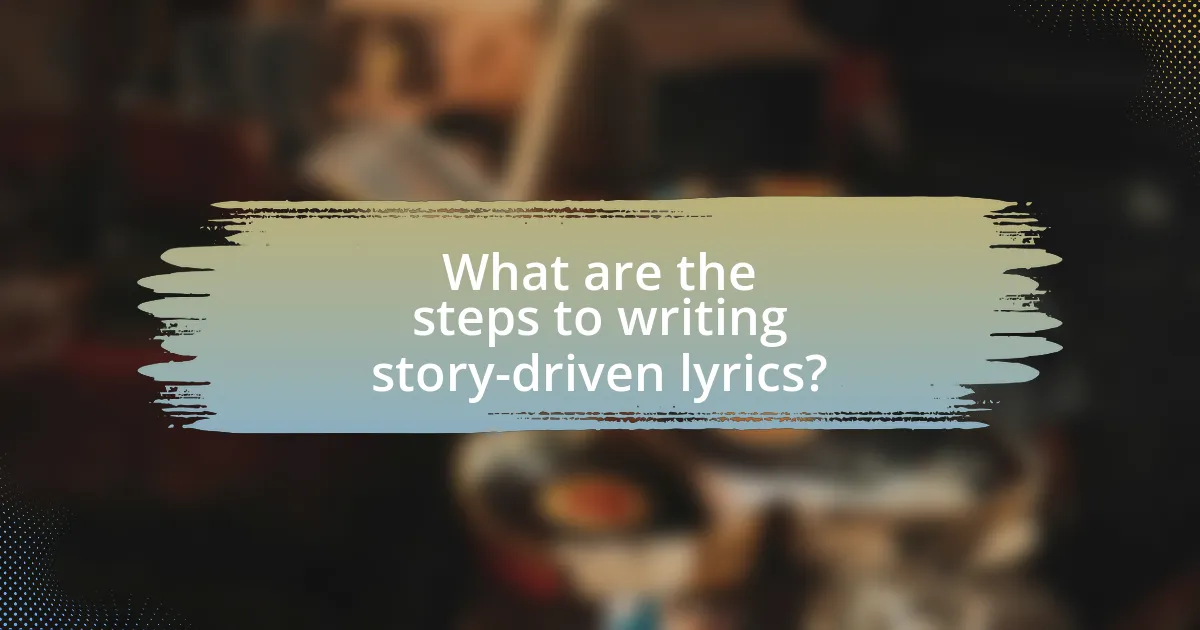
What are the steps to writing story-driven lyrics?
To write story-driven lyrics, follow these steps: first, identify the central theme or story you want to convey. This theme serves as the foundation for your lyrics. Next, develop characters that will inhabit your story; these characters should have distinct traits and motivations that drive the narrative. After establishing characters, outline the plot structure, including the beginning, middle, and end, to create a cohesive storyline. Then, focus on crafting vivid imagery and emotional language that enhances the storytelling aspect of your lyrics. Finally, revise and refine your lyrics to ensure clarity and impact, making sure that each line contributes to the overall narrative. This structured approach is supported by songwriting principles that emphasize the importance of storytelling in engaging listeners.
How do you brainstorm ideas for storytelling in lyrics?
To brainstorm ideas for storytelling in lyrics, start by identifying a central theme or emotion you want to convey. This can be inspired by personal experiences, observations, or universal human experiences. Once the theme is established, create a mind map or list of related images, characters, and scenarios that align with the theme. For instance, if the theme is heartbreak, consider specific memories, feelings, or metaphors that encapsulate that experience.
Additionally, analyzing existing songs that tell compelling stories can provide inspiration and structure. Notable examples include “The River” by Bruce Springsteen and “Fast Car” by Tracy Chapman, which effectively illustrate storytelling through vivid imagery and character development. This method not only generates ideas but also helps in understanding narrative techniques that can be applied to your own lyrics.
What techniques can be used to generate story ideas?
Techniques to generate story ideas include brainstorming, free writing, and using prompts. Brainstorming involves listing ideas without judgment, allowing for creative flow. Free writing encourages writers to write continuously for a set period, which can uncover hidden thoughts and themes. Using prompts, such as “What if?” scenarios or character-driven questions, can spark inspiration by providing a starting point. These methods are supported by writing workshops and educational resources that emphasize their effectiveness in overcoming writer’s block and enhancing creativity.
How can personal experiences influence lyric writing?
Personal experiences significantly influence lyric writing by providing authentic emotions and relatable narratives. When songwriters draw from their own life events, they create lyrics that resonate deeply with listeners, as these experiences often evoke universal feelings of love, loss, joy, or struggle. For instance, artists like Taylor Swift and Ed Sheeran have built their careers on personal storytelling, using specific details from their lives to craft songs that connect with audiences on an emotional level. This connection is supported by research indicating that songs based on personal experiences tend to have higher engagement rates, as listeners find them more relatable and impactful.
What role does structure play in writing story-based lyrics?
Structure plays a crucial role in writing story-based lyrics by providing a framework that guides the narrative flow and emotional impact. A well-defined structure, such as verses, choruses, and bridges, helps to organize ideas, maintain coherence, and enhance the storytelling aspect of the lyrics. For instance, the use of verses can introduce characters and settings, while choruses often encapsulate the main theme or emotional climax, creating a memorable hook. This structured approach allows listeners to follow the story easily and engage with the emotional journey, as evidenced by successful songwriters like Bob Dylan and Taylor Swift, who utilize clear structural elements to convey complex narratives effectively.
How can verses, choruses, and bridges be used effectively?
Verses, choruses, and bridges can be used effectively by structuring them to enhance storytelling in lyrics. Verses typically provide the narrative and detail the story, allowing for character development and setting the scene. For example, in Bob Dylan’s “Tangled Up in Blue,” the verses unfold a complex narrative that engages listeners. Choruses serve as the emotional core, summarizing the main theme or feeling of the song, which can create a memorable hook; in Katy Perry’s “Firework,” the chorus encapsulates empowerment and self-acceptance. Bridges offer contrast and can introduce a twist or a new perspective, adding depth to the song; in “Someone Like You” by Adele, the bridge heightens emotional tension before returning to the final chorus. This strategic use of each section ensures a cohesive and impactful lyrical story.
What are common structures for storytelling in songs?
Common structures for storytelling in songs include the verse-chorus format, narrative arc, and the use of imagery and character development. The verse-chorus format typically alternates between verses that advance the story and a chorus that encapsulates the main theme or emotion, allowing for both detail and repetition. The narrative arc structure follows a clear beginning, middle, and end, often incorporating conflict and resolution, which engages listeners by creating a relatable journey. Additionally, effective storytelling in songs often employs vivid imagery and character development to create emotional connections, making the story more impactful. These structures are widely recognized in popular music, as seen in songs like “The River” by Bruce Springsteen and “Fast Car” by Tracy Chapman, which exemplify these storytelling techniques.
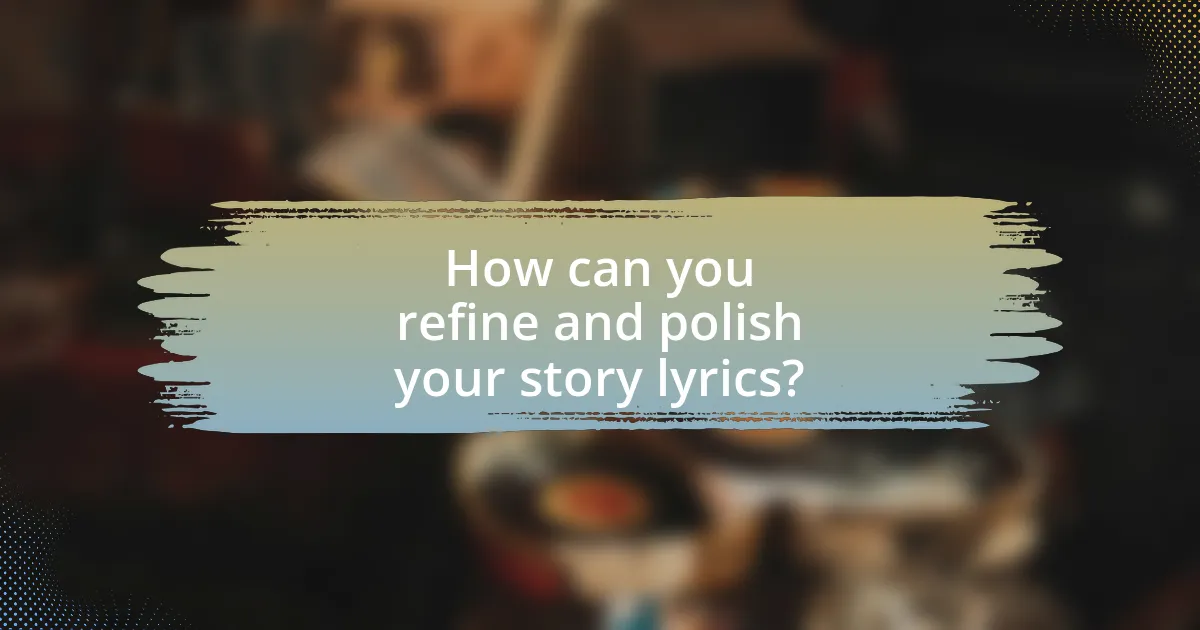
How can you refine and polish your story lyrics?
To refine and polish your story lyrics, focus on clarity, emotional resonance, and structural coherence. Begin by reviewing your lyrics for clarity, ensuring that each line conveys a clear image or emotion. Next, enhance emotional resonance by using vivid imagery and relatable themes that connect with the audience. Additionally, check the structure for coherence; ensure that the narrative flows logically and that each verse builds upon the previous one. Finally, seek feedback from peers or mentors, as external perspectives can highlight areas for improvement that you may overlook.
What techniques can help improve lyric clarity and flow?
To improve lyric clarity and flow, techniques such as using vivid imagery, maintaining consistent rhythm, and employing rhyme schemes are effective. Vivid imagery helps listeners visualize the story, enhancing emotional connection and understanding. Consistent rhythm ensures that the lyrics fit well with the melody, making them easier to follow. Rhyme schemes create a musical quality that aids memorability and engagement. Research indicates that songs with clear structure and lyrical coherence are more likely to resonate with audiences, as evidenced by studies analyzing popular music trends and listener preferences.
How can feedback from others enhance your lyrics?
Feedback from others can enhance your lyrics by providing diverse perspectives that identify strengths and weaknesses in your writing. When you share your lyrics with peers, they can offer insights on clarity, emotional impact, and thematic coherence, which you might overlook. For instance, a study published in the Journal of Creative Behavior found that collaborative feedback significantly improves creative outputs, as it encourages critical thinking and refinement. This process not only helps in polishing your lyrics but also fosters a deeper connection with your audience by ensuring that the message resonates effectively.
What are some common pitfalls to avoid in storytelling lyrics?
Common pitfalls to avoid in storytelling lyrics include excessive abstraction, lack of character development, and weak narrative structure. Excessive abstraction can alienate listeners, as they may struggle to connect with vague imagery or concepts. Lack of character development leads to flat narratives, making it difficult for audiences to engage emotionally with the story. Weak narrative structure, such as failing to establish a clear beginning, middle, and end, can confuse listeners and diminish the impact of the story being told. These pitfalls hinder the effectiveness of storytelling in lyrics, ultimately reducing listener engagement and emotional resonance.
What are some best practices for writing compelling story lyrics?
To write compelling story lyrics, focus on creating a clear narrative arc that includes a beginning, middle, and end. This structure allows listeners to engage with the story emotionally and understand its progression. Incorporate vivid imagery and specific details to paint a picture in the listener’s mind, making the story relatable and immersive. Use strong characters and dialogue to bring the narrative to life, allowing the audience to connect with the emotions and experiences portrayed. Additionally, employing a consistent tone and style throughout the lyrics enhances coherence and reinforces the story’s theme. These practices are supported by successful songwriters who emphasize the importance of storytelling in music, as seen in the works of artists like Bob Dylan and Taylor Swift, who effectively use narrative techniques to captivate their audiences.
How can imagery and metaphor enhance storytelling in lyrics?
Imagery and metaphor enhance storytelling in lyrics by creating vivid mental pictures and deeper emotional connections for listeners. Imagery allows songwriters to evoke sensory experiences, making the narrative more relatable and immersive. For example, when a lyric describes a sunset with colors and feelings, it transports the listener into that moment. Metaphor, on the other hand, conveys complex ideas and emotions succinctly, allowing for layered meanings. A metaphor like “life is a highway” encapsulates the journey of life in a relatable way. Research shows that songs with rich imagery and metaphor are often more memorable and impactful, as they engage listeners’ imaginations and emotions, leading to a stronger connection with the story being told.
What tips can help maintain a consistent narrative voice?
To maintain a consistent narrative voice, writers should establish a clear character perspective and stick to it throughout the piece. This involves defining the character’s tone, language, and emotional state, which should remain uniform to create a cohesive narrative. For instance, if a character is portrayed as humorous, the language and situations should consistently reflect that humor, avoiding shifts to a serious tone that could confuse the audience. Additionally, using a consistent point of view—whether first-person, second-person, or third-person—ensures that the narrative remains focused and aligned with the character’s experiences and thoughts. This approach is supported by narrative theory, which emphasizes the importance of voice in storytelling to enhance reader engagement and comprehension.
How can you apply these techniques to your songwriting process?
To apply storytelling techniques to your songwriting process, start by identifying a central theme or narrative that resonates with your experiences or emotions. This involves outlining the beginning, middle, and end of your story, ensuring that each section contributes to the overall arc. For instance, using character development can enhance relatability; creating a protagonist with clear motivations allows listeners to connect emotionally. Additionally, incorporating vivid imagery and sensory details can paint a more immersive picture, making the lyrics more engaging. Research shows that songs with a strong narrative structure, such as those by Bob Dylan or Taylor Swift, often resonate more deeply with audiences, as they evoke specific emotions and memories tied to the story being told.
